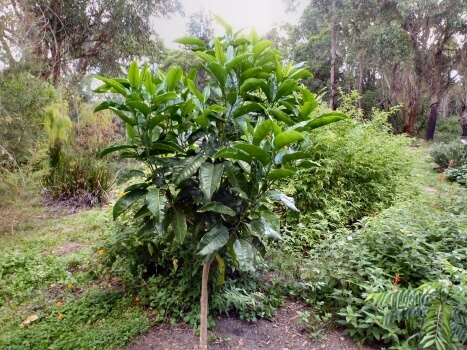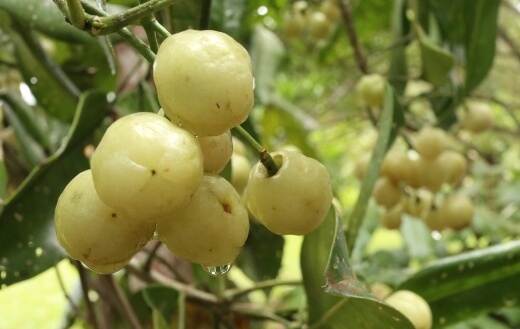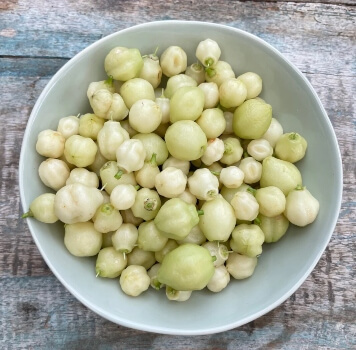A tree that bears fruit is a gift to any garden and gardener. If it’s low maintenance and attracts wildlife such as the lemon aspen, even better. In our how to grow guide, get to know Lemon aspen in more detail.
We’ve got you covered on all the need to know to keep your lemon aspen plant healthy and happy, including propagation, how to care for your tree, pests and diseases, bush tucker info, and some frequently asked questions about this Australian native tree.
More...

Source: Gardening With Angus
Family: | Rutaceae |
|---|---|
Genus: | Acronychia |
Species: | A. acidula |
Common Names: | Lemon aspen, lemon wood |
Location: | Outdoor |
Type: | Tree |
Growth: | Up to 15 metres tall and 8 metres wide |
Sun requirements: | Full sun, part shade |
Foliage Colour: | Dark green |
Flower Colour: | White |
Flowering: | Summer, Autumn |
Fruit: | Pale lemon coloured small edible fruit |
Maintenance level: | Low |
Poisonous for pets: | No |
Introducing Lemon Aspen

Source: Rainforest Heart
Lemon aspen is botanically known as Acronychia acidula. In nature, it favours tropical forest as a habitat and particularly in the northern part of Queensland. It is also found along the coast in Sydney.
As the name suggests, the tree is a citrus that offers up small fruits that you can eat. The taste is something between lime and grapefruit. Perhaps you have heard Lemon aspen being called rainforest lemon – that is because it is ultimately a rainforest species.
The fruit of the Lemon aspen, or berries as they are called, tend to be a light green to almost white colour and they grow together in bunches. These lovelies can be enjoyed raw or cooked and offer a whole variety of culinary uses and inspiration including puddings and sauces.
Lemon aspen offers a bit of health benefits – the fruit is incredibly high in antioxidants and is packed with zinc and iron.
Acronychia acidula Plant Features
Lemon aspen trees produce small white flowers in the summertime and into autumn. After the flowers come the fruit from autumn into winter time. When the fruit of the Lemon aspen is ripe it will fall to the ground. If you are hoping to harvest a bit more fruit you can give the tree branches a bit of a shake.
How to Grow Lemon Aspen

Source: Rosebank Growers
These trees like to live and grow in a sunny spot. They do not like wind and frost so keep this in mind when choosing a planting site. The soil you use should be well-draining and remain moist. If your location has sandy soil then be sure to add some organic matter.
If you enjoy a low maintenance garden or particularly a low maintenance tree, the Lemon aspen is a great choice. You can grow it successfully in a pot if you like and it also works ideally as a hedge. You can just prune accordingly to keep the size that you want.
Propagating Lemon Aspen Plant
It is fairly simple to propagate your own Lemon aspen tree using a semi hardwood cutting. You’ll need to choose a branch that shows new growth as this is an indication of good health. Avoid branches that are already growing fruit otherwise the plant will use its resources to maintain the fruit instead of growing new roots.
When you cut your chosen branch, you need to ensure that it has at least 2 nodes on it. This is where the leaves grow out from the stem and is ultimately where new roots will form.
Take off the lower leaves and leave the ones just at the end of the cutting. Dip the end of the cutting in a rooting hormone as this will help root growth. You can then plant the cutting directly into a pot of soil that has been moistened.
To help create a greenhouse effect, you can place a clear plastic bag over the cutting and then put it somewhere that has bright but not direct light. Once the cutting has reached a year in age, you can plant it out in the garden.
How to Care for Lemon Aspen
Temperature
Since the Lemon aspen is tropical by nature, you would imagine that cold and frost are big things to avoid. This tree can in fact handle low temperatures and a mild frost once it has established itself.
Pruning Lemon Aspen
The Lemon aspen should ideally be pruned sometime in its first year. This helps to create the shrub like shape and creates a few main trunks. In the years that follow, you can give your tree a light pruning so that sunlight can actually reach the canopy.
Sunlight
Lemon aspen can grow well in full sun and you will see it at its best this way, but can also be happy in partial shade.
Best Soil to Use
Your Lemon aspen will be at its best if you give it moist and well-draining soil. If you are living in Western Australia or any region that has a sandy soil, be sure to add lots of organic matter to the soil.
It’s also a good idea to mulch the ground before summertime arrives. In the case of a more clay soil, you can add lots of compost.
Recommended Fertiliser
When it comes to feeding your Lemon aspen, we recommend using a slow release citrus fertiliser in the springtime.
Watering Needs
When the Lemon aspen tree is young, you can water quite generously. When the tree is established, it then becomes more drought tolerant.
Lemon Aspen Bush Tucker Guide

Source: Noosa Natives
Lemon aspen fruit are quite small and can be a light green, yellow or even a whitish colour. They grow in bunches and contain black seeds that grow in a star pattern. Lemon aspen fruit has been used by the Aborigines for many years, for both medicinal and culinary uses.
The Lemon aspen fruit gives off a tropical citrus smell and has a lovely tart lemon taste with a spicy note to it, and a touch of grapefruit. If you are looking to pair it with other fruits, it goes really well with quandongs and muntries.
The fruit is best picked when it’s just under ripe. Here’s a fun fact – 100 grams of Lemon aspen is the equivalent of the juice, zest and pulp of 6 big lemons.
Lemon aspen fruit can be enjoyed raw or cooked. If your preference is to eat it raw, they can be eaten fresh or you could make a nice chutney. The fruit has so many delicious culinary uses. These include syrups, sauces, marinades, and of course desserts.
Lemon aspen is also popular as a flavouring for juice, mineral water and wine. When it’s dried, you can actually grind up Lemon aspen to make a spice. The fruit is generally available from the middle of summer and into the autumn months.
Lemon aspen can be preserved in sugar syrup or sweet vinegar. The fruit spoils easily and you’ll need to pop it into the fridge within 12 to 24 hours. You can keep it in the fridge for three weeks and in the freezer for two years.
Pests and Diseases that Affect Lemon Aspen
Citrus leaf miner
The citrus leaf miner is a tiny moth that can barely be seen. They are covered in shiny white scales and have a black spot on the tip of their wings. The females lay eggs on the underside of the leaves and once the larvae develop, they then dig tunnels into the leaves.
You might actually notice the holes on the leaves where they are being eaten. You might also see that the leaves of your Lemon aspen start to curl and the edges of the leaves begin to roll up.
A great way to deal with these pests is to use neem oil which can be sprayed onto the affected leaves. It manages to get rid of the moths and their larvae.
Also, refer to our guide if you notice citrus leaf curl to learn how to deal with them.
Lemon Aspen Frequently Asked Questions

Source: Rainforest Heart
When was Lemon aspen first discovered?
The Lemon aspen tree was first described in 1864 by the Victorian state botanist Ferdinand von Mueller. The species name acidula is Latin for “slightly acid”.
At what kind of altitude does Lemon aspen grow?
In its natural habitat of rainforest, the Lemon aspen tree grows at altitudes of up to 1000 metres.
What kind of birds eat the Lemon aspen?
The topknot pigeon absolutely loves the tasty fruit.
Does the Lemon aspen have any cultural references?
The Lemon aspen tree appeared on an Australian postage stamp in 2019.
What are some of the nutritional benefits of Lemon aspen?
The fruit has high levels of calcium, potassium, iron and magnesium and also phosphorus, folate and zinc.
What are the medicinal benefits of Lemon aspen?
The fruit of the Lemon aspen has plenty of antioxidants and contains much needed vitamins and minerals for the body. It can help to boost the immune system and reduce flu and cold risk, it protects the skin from the UV rays of the sun, can help with the healing of wounds, and also reduces free radicals.
Looking for more gardening inspiration? Sign up for our newsletter.
Wrapping Up Our Lemon Aspen Growing and Care Guide
The Lemon aspen tree brings some rainforest charm to the Australian garden and delights with its fragrant and delicious fruit. Easy to propagate and maintain, this tree and its fruit is packed with nutritional goodness and will have you trying out plenty of new recipes.
Published on February 8, 2023 by Nathan Schwartz
Last Updated on February 23, 2024





where can I buy seeds in WA
Hey Colin,
I found that https://guildfordgardencentre.com.au/about/delivery/ deliver to Perth, I couldn’t find seeds for lemon aspen but here is the link for a plant, and you can be notified when back in stock. https://guildfordgardencentre.com.au/product/lemon-aspen-tucker-bush/.
I hope this helps.
Gary Clarke